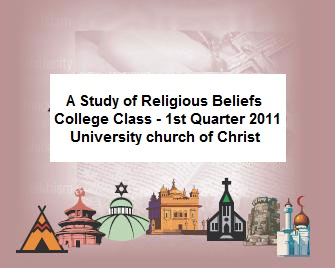Home | About Us | Directions | Bulletins | Sermons & Audio | Cross Of Christ Studies | Classes | Student and Parent Resource Page | Dangers Facing the "Non-Traditional"
Gospel Preaching and the Carnegie Approach (Part 1)
by J. Curtis Manor
It is now almost two decades since Dale Carnegie first published his famous book, How to Win Friends and Influence People, a down-to-earth, easy-to-read, entertaining and practical guide-book on applied psychology. It contained no new truths or concepts, the technique it presented was at least as old as Abraham; but it was a new and refreshing work, in that it condensed into plain, everyday United States English the essentials of applied psychology and summarized in the same short volume the diplomatic techniques of many of the world's most successful men. The book was a smash hit. It was received by a depression-ridden, hence competition-conscious public as a godsend, and Mr. Carnegie soon found that he had become, through the circulation of this book alone, the most widely read non-fiction author of this century His book quickly became the standard modern work on human relations, a position it retains to this day.
Mr. Carnegie has become so identified in the minds of many with the "salesmanship" technique in handling people that he is well nigh given full credit for having invented it. This is not the case, of course, nor does he make any such claim. Actually, every major principle set forth in the book, How to Win Friends and Influence People is either taught or exemplified in another and much older Book, by an even more eminent Author, which also deals to some extent with the subject of human relations. The Carnegie book has been successful, not because it is new, but because it is true — true to human nature, and true to the author's purpose in writing it which was to produce, as he puts it, "a practical, working handbook on human relations."
But the purpose of this article is to deal with the specific question of the "Carnegie approach" in preaching the gospel. Many a time I have been advised by preachers and other brethren: "Study Dale Carnegie's book and apply it to your preaching. Read it over several times a year and check yourself by it. You'll find yourself converting more people than you ever thought possible."
And I know of many preachers who follow this or similar advice with evident success. The number of baptisms reported by them in the papers is often quite impressive, and their ability and reputation for "building up" a congregation are beyond question. I am speaking now of preachers who are sincere in their use of the Carnegie technique; not of those who make an artificial use of it, so that you can practically see the hypocrisy dripping from their very pores — although the system is so effective and so in line with the workings of the human mind that it will often yield a generous fruitage, even in the hands of a two-faced flatterer.
A Misfit in the Pulpit
Yet in spite of the undeniable statistics attesting to the effectiveness of "Win Friends and Influence People" measures in preaching, I have maintained, in company, I believe, with most gospel preachers, that this technique has no place in the Lord's pulpit. I consider it a gross misfit, and shall continue so to regard it until convinced otherwise, not by mere baptismal statistics, but by scriptural arguments and the concrete fruits of real, steadfast Christianity.
For it has been my observation that the salesmanship approach in preaching rarely results in genuine conversion to Christ and loyalty to his doctrine. I've known of too many "Carnegie converts" who were later "driven away" when they heard the gospel preached candidly by some poor uninformed preacher who knew nothing but Bible; and too many others who, instead of being driven away, remained in the fellowship of the church only to be the devil's fifth column in every battle between truth and local error, apologizing for gospel truth and forming a pressure group to engage only preachers who will "just preach the gospel and let other people's religion alone." In addition there have been not a few "Win Friends" converts within my own experience that have later come requesting to be “rebaptized”: they had been won by the power of salesmanship to change their religious affiliation—simply to transfer from one denomination to what they had regarded as another rather than being convicted of sin by the power of the gospel and offering penitent submission to God's will. They had previously "joined the church;" now they had learned the truth plainly and wanted to obey the gospel. Such developments as these, of course, are seldom reported in the field reports of the papers to offset the pleasant illusion created by the swelling numbers.
But, to get straight to the point: it is all but impossible to really convert sinners by preaching with the Carnegie approach! And if true conversions are accomplished, the result is gained in spite of this method rather than because of it!
Does that sound a little incongruous? Someone is no doubt read), to say: "Hold on there, Manor; you just said the Carnegie approach was an effective, workable system based on true concepts of human nature, even as demonstrated in the Bible itself. You admitted that it gets results—and now you jump the fence and say it can't be used to convert people to Christ! Which side of this fence are you on, anyway?"
Both sides.
Stay in the Right Field
Let us not forget that the place and purpose of the Carnegie technique is in the field of social human relations, and in this field, let me say again, it is unsurpassed for effectiveness. But remember that the prime purpose and design of the gospel of Christ is in the field of divine relations. Its foremost emphasis is upon man's relationship, not with other men, but with God. Paul wrote to the Christians at Corinth that God "reconciled us to himself through Christ, and gave unto us the ministry of reconciliation; to wit, that God was in Christ, reconciling the world unto himself, not reckoning unto them their trespasses, and having committed unto us the word of reconciliation" (1 Cor. 5:18, 19). All accomplishments of the gospel of Christ in the field of social relations are secondary and incidental to this one fundamental. Any man, therefore, who seeks to reconcile either himself or others to God by following the directions of "a practical handbook on human relations" has not only placed the cart before the horse-he has left the horse at home in the barn. He has fallen into the trap occupied by the wicked of David's time, to whom God said, "Thou thoughtest that I was altogether such an one as thyself" (Ps. 50:21). He shares the error of the wayward Israelites, whom God had to remind: "My thoughts are not your thoughts, neither are your ways my ways" (Is. 55:8).
"Oh, but we don't advocate any departure from the word of God," someone may say. "We preach the full gospel, but we use the proven principles of salesmanship as outlined in the Carnegie book in our presentation. Certainly the prime objective of the gospel is to reconcile men to God. But men are human, and if many of them ever are to receive the gospel, it must be presented to them in a palatable, inoffensive way, otherwise you'll defeat your own purpose-and God's-by driving them away. You just can't ignore human nature and expect to reach many people."
With this last statement I agree, and will show in the course of this study that a rejection of the Carnegie approach in preaching does not ignore, but rather acknowledges the fundamentals of human nature. But it is as impossible to preach the full gospel by presenting it according to the Carnegie system as it is to ride two horses travelling in opposite directions at the same time. For in their fundamental workings, the two are opposites. Like oil and water or light and darkness, they do not mix. Here's why:
Contrast of Basic Principles
The Carnegie system of persuasion is biased upon and built around the gratification of a man's sense of his own importance. It is calculated to cater to a man's opinion of himself, to feed his ego, to make his mistakes seem unimportant and his faults negligible and easy to correct. It presupposes a desired course of action to be readily compatible with the man's present outlook and background. It avoids censure or criticism and flatly rejects direct argumentation. It seeks to woo him by an appeal to his sense of magnanimity, his desire for praise, his feeling of power in condescension. It deals with a comparison between the good and the better, from a man's own viewpoint of values as applied to himself; never with a contrast between the good and the bad.
Gospel conversion, in sharp contrast with the above, is predicated upon a man's sense of his own unworthiness, and the gospel of Christ is calculated to destroy his egotism, to bring him to a realization of the enormity of his sins and of his own utter helplessness to correct them. It shows the one accept-. able way to be incompatible with any and all other ways, regardless of personal outlook or background. It "reproves, rebukes and exhorts" with a clear-cut condemnation of all that is sinful, and makes use of argumentation as a favored method of persuasion. It deals with a contrast between the good and the evil in respect to the man himself. It seeks to bring him, not to a condescension, but to a humble repentance based upon godly sorrow, lowliness of mind, humility of spirit and a fervent desire for the mercy of God.
In short, "salesmanship" persuasion leads a man to change his course of action "painlessly," because it allows him to retain his full sense of independence. But, Gospel persuasion aims at a full and complete surrender of man's independence to the authority and will of God. For this there is no substitute. Anything less than this cannot qualify as true conversion in the Bible sense.
The results of the two methods of preaching may appear to be identical for a time—at least long enough to allow the baptismal statistics to be published for the brotherhood to admire—but when an occasion does arise wherein the requirements of God's word clash with the natural inclinations of the human will-as in a case of church discipline, selection of elders, submission to the overseers, exposition of denominational error, or "hard" preaching to the church-the difference in quality between the products of the two is often quite forcefully demonstrated.
- Preceptor, April 1954(To be Continued)
Other Articles
Gospel Preaching and the Carnegie Approach (Part 2)
Preach Christ and Not...
The Simple Power of the Lord's Supper
Jesus the Humble Servant









